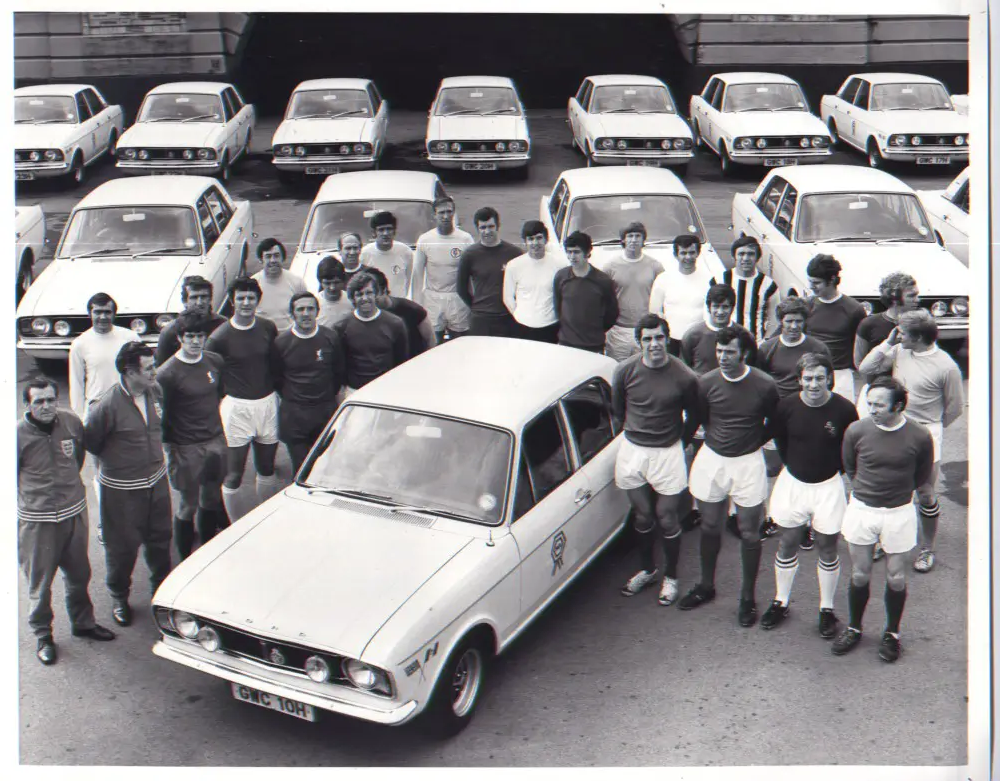YOUR CHANCE TO OWN THE PETER SELLERS ASTON MARTIN DB4 GT
24 May 2023
You’re driving along in your spanking new Cortina 1600E and your wife starts nagging you so you suggest she reclines her seat and before long she’s dozed off because the 1600E is so quiet and you look at your reflection in the plushy walnut dashboard and think how closely you resemble Gregory Peck and with a roar of the 1600GT engine, you twiddle the aluminium steering wheel and the sculptured racing wheels screech as you take the chicane at 85 and tap tap the man on the Ford stand wakes you up.
That was how Ford promoted the Cortina 1600E in the late 1960s. A few years ago, I referred to it as “a reasonably priced Ford for the sort of motorist who knew their way around The Len Deighton Action Cookbook”. I stand by that description, only adding it was equally suited to the young solicitor who dared to affect a Simon Dee hairstyle.

‘E’ stood for “Executive”; the name used by Ford GB for their range-topping cars since the introduction in January 1965 of an exclusive version of the Zodiac Mk. III. The replacement Zodiac Executive Mk. IV followed in April 1966, while the Corsair 2000E of January 1967 was aimed directly at the Rover P6/Triumph 2000 ‘compact prestige’ car market.
Nine months later, Ford launched the Cortina 1600E, with the GT’s engine and rear axle combined with the Cortina Lotus’s lowered suspension with stiffer damper and spring settings. The cost was £982 2s 1d - £100 more than the GT – with a specification that included reclining front seats, twin Wipac 562 spot lights, a clock, reversing lamps, a cigar lighter (for that post-business lunch Panatella) and some splendid Ro-Style wheels. For additional distinction, the 1600E’s fascia and door cappings were trimmed in polished wood, complemented by a leather-covered steering wheel rim.
The Telegraph thought the 1600E was suited to “fashion-conscious” motorists, which is true up to a point. Its external appearance and the décor were smart and contemporary without being overly flamboyant. Motor Sport may have complained, “I do not think a wooden interior décor looks right in a modern ‘tin saloon’” – but 58,833 motorists disagreed. The 1600E exceeded Ford’s sales expectations and added lustre to its 1300 De Luxe stablemate in the same showroom. Dagenham accurately claimed the 1600E was their “best advertisement yet”.
And in 1967, the Cortina 1600E really did appear to stand alone in the UK car market. The new Humber Sceptre ‘Arrow’ had a slightly more middle-aged image, while BMC’s MG Magnette Mk. IV and Riley 4/72 ‘Farinas’ were redolent of the 1950s. Vauxhall did not offer a VX 4/90 version of their FD range until the 1970 model year, but that was a larger saloon and more of a Corsair rival.
For 1969, the 1600E gained an improved transmission, an internal bonnet release, a modified fascia with a centre console, and bucket-style rear seats. Production of all Cortina Mk. IIs ceased in 1970, and a final hurrah was Dahgenham lending the England World Cup Squad 1600E they would drive for a year. They would then return the Cortina to the factory or buy it at a discount. A Ford press release stated:
the cars were all registered GWC (Great World Cup) 1 to 30. Bobby Moore of West Ham was handed GWC 1. Bobby Charlton had No. 9 and Geoff Hurst No. 10, the numbers they wear on their shirts.
48 years later, Francis Lee told The Independent:
This was a top car at the time. My wife drove it and when the year was up I recall paying around £600 to £700 for it. The only problem I had with it was the stickers as it attracted too much attention. If some people who supported a rival team knew it was my car then they would leave their mark. Over the years I had three cars quite badly damaged. So after about six months I part-exchanged it at a Ford dealer for £1,250. They wanted me to have a Zodiac, but I really didn’t fancy that at all.
Back at Dagenham, the GXL Mk. III became the new Cortina flagship in late 1970, but it never quite captured the zeitgeist of the 1600E. When Ford introduced a 2000E version in 1973, the advertisements were even headed with the words, “Now will you please stop writing to us about the old 1600E?” But no car could really succeed the Cortina with a wooden veneered fascia and “sculptured racing wheels”.
